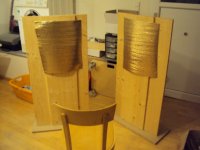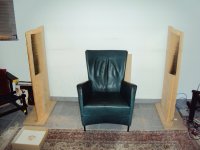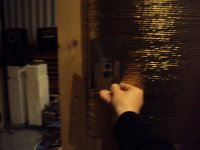Hi Joachim, I'm wondering how well it workedI heard it ones before 1980 on a HiFi show in Düsseldorf and it worked.
Did you hear the Snell with a cover on the front or were the drivers visible? Where did the sound appear to come from? Did you sit or stand in front of the Snell when listening?
Rudolf
As is said, the room was big and the speakers where quite far from walls.
I sat maybe more then 3m away. As far as i can remember the speakers where not angled in and they where quite far apart, say 3m.
Under that conditions the imaging was much higher then the drivers on the floor.
Well, this is over 30 years ago.
Today i actually did some experiments with angled mirrors on the floor.
Actually it is too early to tell if that makes any sense.
I asume that in a typical european 25qm room this may not work as well.
I sat maybe more then 3m away. As far as i can remember the speakers where not angled in and they where quite far apart, say 3m.
Under that conditions the imaging was much higher then the drivers on the floor.
Well, this is over 30 years ago.
Today i actually did some experiments with angled mirrors on the floor.
Actually it is too early to tell if that makes any sense.
I asume that in a typical european 25qm room this may not work as well.
Here is a discussion of the Snell Type 1 :
Snell type 1? - Snell - The Classic Speaker Pages Discussion Forums
I am starting to read it.
Snell type 1? - Snell - The Classic Speaker Pages Discussion Forums
I am starting to read it.
http://members.rennlist.org/lt_texan/Snell1p2.pdf
They say that staging is good but unfortunately they do not say if the image had any appreciable height.
Well, this was the infancy of high end and Harry Pearson just had coined the word " Sound Stage".
They say that staging is good but unfortunately they do not say if the image had any appreciable height.
Well, this was the infancy of high end and Harry Pearson just had coined the word " Sound Stage".
A guy brought a pair to the Scalford show in the UK back in March, he was running them with decent amps and source and they still sounded very good. Slightly warm, with a pretty even response in a big room and decent staging. They were more than 12 feet apart so difficult to tell too much about how precise they could image, but they were universally liked by the majority of patrons who commented.
Garrard 401, An arm, AN step-up, Alnic Head, Modwright power.
Garrard 401, An arm, AN step-up, Alnic Head, Modwright power.
An externally hosted image should be here but it was not working when we last tested it.
An externally hosted image should be here but it was not working when we last tested it.
I own a pair of Snell Type A.
I found them a bit veiled but tonal balance is good.
It lacks a bit of resolution and is not very dynamic.
I atribute that to the rather simple drive units and a very complex crossover with parts that would not be used today any more.
A long time ago i heard them in a big room and they had very good sound staging.
I find the concept fascinating. The woofer is down firing so it couples well to the room without floor notch. The wide and rounded baffle solves diffraction problems.
This with modern drive units and crossovers could be something special.
I found them a bit veiled but tonal balance is good.
It lacks a bit of resolution and is not very dynamic.
I atribute that to the rather simple drive units and a very complex crossover with parts that would not be used today any more.
A long time ago i heard them in a big room and they had very good sound staging.
I find the concept fascinating. The woofer is down firing so it couples well to the room without floor notch. The wide and rounded baffle solves diffraction problems.
This with modern drive units and crossovers could be something special.
Here is a discussion of the Snell Type 1 :
Snell type 1? - Snell - The Classic Speaker Pages Discussion Forums
I am starting to read it.
extensively discussed here at diyaudio: http://www.diyaudio.com/forums/multi-way/121385-advantages-floor-coupled-up-firing-speakers-252.html
please join in if You like
I saw in another thread a discussion how reflective baffles can be used to advantage.
I liked the version with the baffles on the sides of the ears. I think they do at least two things : producing lateral reflexions and mixing some of the output of the left speaker into the right ear and wise versa. They are also shielding longer lateral reflexions from the side walls.
So i build two baffles and listened.
The effect is a bit like the Linkwitz Watsons but without the pressure on the ears.
This system also does not need an amp plus delay and it is dirt cheep.
The L-R, R-L cancelation should improve separation and it does to a certain degree.
The lateral reflexions should give some pleasant spaciousness and the shielding of the side walls should reduce artificial reverberation from the listening room.
Actually the sound is more focussed and separated. The effect can be adjusted a bit by sitting more or less backward and forward. Sitting maximum backward gives the strongest focus but also a slight claustrophobic effect.
I found the sound best when the reflexions of the speakers are focussed on the ears.
That gives very good focus with natural spaciousness when the recording allows.
That is approximate when the ears are in the middle of the panel.
See a picture where i hold a mirror to the right panel and you see the left speaker.
I liked the version with the baffles on the sides of the ears. I think they do at least two things : producing lateral reflexions and mixing some of the output of the left speaker into the right ear and wise versa. They are also shielding longer lateral reflexions from the side walls.
So i build two baffles and listened.
The effect is a bit like the Linkwitz Watsons but without the pressure on the ears.
This system also does not need an amp plus delay and it is dirt cheep.
The L-R, R-L cancelation should improve separation and it does to a certain degree.
The lateral reflexions should give some pleasant spaciousness and the shielding of the side walls should reduce artificial reverberation from the listening room.
Actually the sound is more focussed and separated. The effect can be adjusted a bit by sitting more or less backward and forward. Sitting maximum backward gives the strongest focus but also a slight claustrophobic effect.
I found the sound best when the reflexions of the speakers are focussed on the ears.
That gives very good focus with natural spaciousness when the recording allows.
That is approximate when the ears are in the middle of the panel.
See a picture where i hold a mirror to the right panel and you see the left speaker.
Attachments
Voice coilless woofers... cool
I saw in another thread a discussion how reflective baffles can be used to advantage.
I liked the version with the baffles on the sides of the ears. I think they do at least two things : producing lateral reflexions and mixing some of the output of the left speaker into the right ear and wise versa. They are also shielding longer lateral reflexions from the side walls.
So i build two baffles and listened.
The effect is a bit like the Linkwitz Watsons but without the pressure on the ears.
This system also does not need an amp plus delay and it is dirt cheep.
The L-R, R-L cancelation should improve separation and it does to a certain degree.
The lateral reflexions should give some pleasant spaciousness and the shielding of the side walls should reduce artificial reverberation from the listening room.
Actually the sound is more focussed and separated. The effect can be adjusted a bit by sitting more or less backward and forward. Sitting maximum backward gives the strongest focus but also a slight claustrophobic effect.
I found the sound best when the reflexions of the speakers are focussed on the ears.
That gives very good focus with natural spaciousness when the recording allows.
That is approximate when the ears are in the middle of the panel.
See a picture where i hold a mirror to the right panel and you see the left speaker.
What drive units are you using ? What is the purpose of the shinning cover ?
Last edited:
This reflectors are all passive. The gold foils covers some holes from another experiment.
The foil is slightly bend so i thought that the refections get a bit scattered.
I did some more listening tests. It is quite fascination to move the seat back and forward.
I am now sitting 5cm more forward then yesterday and the sound is even more natural.
If i sit even more forward then this the sound gets less focussed and "weaker" in energy. If i sit more backwards there is more slam ( much more ) and focus ( slightly more ) but there also comes a kind of hollow tonality.
The foil is slightly bend so i thought that the refections get a bit scattered.
I did some more listening tests. It is quite fascination to move the seat back and forward.
I am now sitting 5cm more forward then yesterday and the sound is even more natural.
If i sit even more forward then this the sound gets less focussed and "weaker" in energy. If i sit more backwards there is more slam ( much more ) and focus ( slightly more ) but there also comes a kind of hollow tonality.


